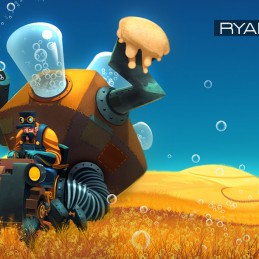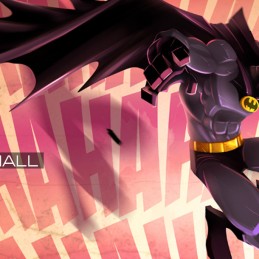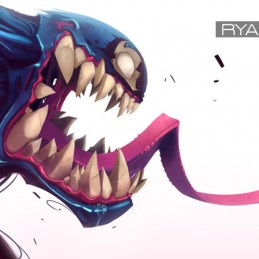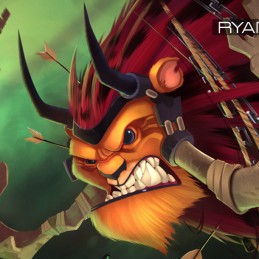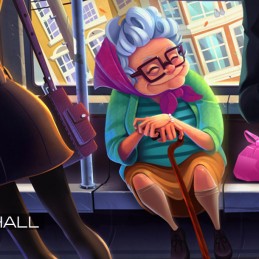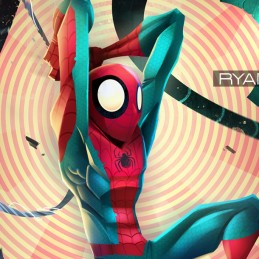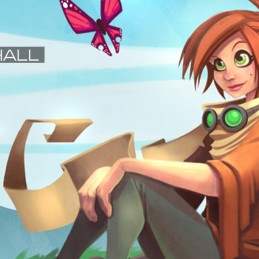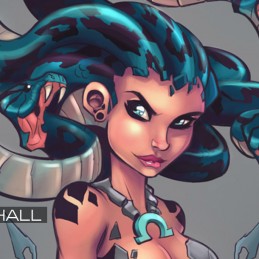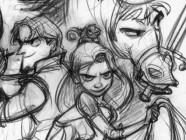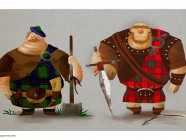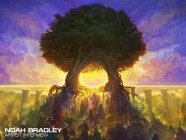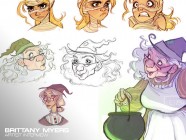
Vibrant, energetic and full of attitude are words that can be associated with the art of Ryan Hall, also known as Frogbillgo on DeviantArt. His brilliant cartoon styling exudes masses of energy and force, and his excellent grasp of form is clearly seen in the three dimensionality of his works. When it comes to colouring and painting, Ryans vibrant yet contrasting use of colour brings out even more life and drama in his art. We took the opportunity to speak with him recently, and here’s what he had to say.
Hey there Ryan, how’s life? What’s happening in your art world, and can you tell us a little bit about Sketchbomb?
Hello! Life is good! I’m currently working fulltime with Booyah in San Francisco and working on new personal ideas. I’ve been kicking around the idea of putting out a book, so most of my personal stuff lately has been geared to fulfill the body of work I feel the book needs.
Sketchbomb all started when I moved out to San Francisco about 2 and a half years ago. My friend Mike Henry was already living in the Bay Area and we immediately started talking about how we need to get a sketch group together. Right around that time, we heard about a cafe called “The Grove” just opening up a new location on 3rd and Mission and thought it was a perfect spot for all ages to grab some food and network while doing some theme-based drawings. We’ve been meeting there once a month and have opened up additional chapters in several other cities since then. All of the information for checking out art from the group, times and locations can be found at sketchbomb-sf.deviantart.com.
It’s clear you’ve been drawing for a very long time. What are some of your earliest memories creating art? What age did you really start getting into it?
Yeah, I’ve been drawing as long as I can remember. My mom was working as a graphic designer / animator before I was born. The stuff she did involved a lot of drawing using traditional materials so I had a great teacher right off the bat. The first drawing I remember doing was an ice cream sundae. With my kid-brain logic I then concluded that if I can draw this, then I can draw super heroes! I filled up lined paper notebooks with any kind of hero I could come up with. As I got older, I studied any comic book and how-to-draw book I could get my hands on. Right around high school was when I started thinking about doing art as a profession. I got my first paid indie comic side gig when I was 16 and pushed on from there.
You have such a dynamic style – who would you name as some of your key inspirations? What elements of life inspire your artwork from day to day?
I try my best to mix my life experiences with my media-based influences. I’m heavily influenced by comic books, animation, movies, video games, and traditional art. However, I feel that adding inspirations from real life, as small or abstract as they may be, can really give art that extra element of uniqueness. I feel that balancing these two sources of inspiration has been effective in connecting with the viewer. I spend a lot of time drawing in cafes trying to come up with ideas based on the characters and environment around me. I feel most inspired whenever I’m pulled out of my day-to-day routine. Sometimes I’m stuck sitting at my desk, so I’ll usually listen to music, podcasts, and documentaries while drawing to help spark new ideas. As far as specific influential artists go, I’m a huge fan of Joe Madureira, Humberto Ramos, J. Scott Campbell, Norman Rockwell, Alphonse Mucha, Egon Schiele, and J.C. Leyendecker.
We’ve watched some of your great instructional videos on Youtube (Link) and encourage readers to take a look. How would you describe your average workflow when creating art? How much of your idea is in your mind before you start working?
Glad to hear you dig the videos! I decided to make these because I remember how much I wanted to pick the brains of artists I followed. This aspect is pretty new to me so I’m still trying to get the knack of the editing part, haha. I usually start any piece with super rough, messy drawings in my sketchbook. The ideas are usually based off of a visualization I’ve had stuck in my mind for some reason or from the results of messing around on paper. Most of my initial roughs are illegible to everyone else. I try to keep my work as loose as possible up until the final lines or colors are put down because during the “cleanup phase” the motion and life of a piece can be lost very quickly. On any given piece, I usually spend the bulk of the time on the planning phase. I learned that if I get to the final stage and certain elements aren’t planned for, whether it be a character’s hand or something in the background, I end up spending a much larger amount of time trying to fix it or even having to redo the whole thing.
When I intend to have linework be my final product, I will use layers of tracing paper and light board the final lines on bristol when working traditionally. When working digitally, I tighten my lines across the span of several layers. (In Photoshop or Sketchbook Pro)
If I plan on painting something digitally, I normally don’t bring the piece to final lines. I usually just scan in my messy sketch and block in my colors on a separate layer at darker values than what I intend to be the final result. Once I have it all blocked in, I build my colors up and finish off the piece with highlights, popping in extreme shadows that are needed, and textures.
Your art has a lot of attitude and a ton of energy – was this intentional? How can other artists learn from you, and get that secret to energy in their artwork?
I’m always trying to push the sense of life and/or energy in my pieces. Starting a drawing rough and loose is the key to capturing energy and a sense of movement. Starting off carefree helps keep the drawing from becoming too stiff. When moving onto the final lines, I try to make my strokes as quick as possible. Fast lines equal a fast subject. Slow lines usually result in wonky line quality. Once I get those quick lines down, I then go over the lines again to add varying line weight. I feel that tapering a line will help give the piece a better sense of movement. Squashing and stretching shapes, pushing perspective and adding in elements like debris, trailing cloth, and pushing the subject in a specific direction will help add to a dynamic composition.
We’d love to know what tools you work with when creating art. Do you work mainly digitally, or traditionally? What software and tools do you use?
I used to be very attached to traditional mediums, but as soon as I got my hands on a Wacom Cintiq, I pretty much haven’t looked back when it comes to creating work for clients. I still draw on paper during my rough concept phase and sometimes for personal use, but when working on a project with someone, I have to be able to make changes and often need to create multiple variations of my designs on the fly. I generally like to use SketchBook Pro for linework and use Photoshop for all of my coloring. I use a lot of layers and folders when working digitally so I can easily turn elements in the file on and off.
When painting digitally, I use a lot of masks to keep my colors from “going outside the lines.” I find that this saves a ton of time when coloring a specific object in the composition. Once I’m done with the base colors, I will then create a layer above the mask to add things “outside of the lines” like bloom lighting, highlights and topical details.
As far as Photoshop brushes, I like to build my colors up with the standard no-taper, hard-edged, circular brush with my flow set to around 10-30%. I sparingly use the soft brushes to smooth things out. I feel like when I use the soft brushes, the colors start losing a certain “human touch.” I also use various texture brushes I either made or found online.These are usually just “textural stamps” that I apply to the image in the end stages.
Do you think it’s important for artists to have a formal education, or would they be able to progress in skill by themselves, using online resources?
I’ve heard good and bad experiences from both routes. I think it really depends on the individual artist and what they want to accomplish. I went to NCSU College of Design and it was a great, worthwhile experience. It made me step out of my comfort zone, I was led by experienced professors, had access to valuable resources provided by the university, and I learned a lot just from being around a wide variety of artists. But what it all boils down to is the artist’s motivation, how good your portfolio is and how well you work in a professional environment when pursuing a career in the games industry. Whatever educational route you take, I highly suggest trying to gather feedback, advice, and technical information from as many credible sources as possible and then decide what methods work best for you. Once you have this information from whatever educational direction you chose, it’s ultimately up to you to put it all to use.
There is more and more interest in digital art each day – what would be the best advice you would give to someone just starting out in creating art?
I think that applying digital techniques is an exponential additional amount of aspects to consider when someone is just starting out. I still believe that a pencil and paper is where to begin. Start with the basics to build a strong foundation. I suggest warming up with very quick gesture drawings whenever sitting down to draw. Draw everything you see and experiment with shapes. Once you feel comfortable with what you’re drawing it’s probably time to step out of that comfort zone and try drawing something new. Once a solid understanding of the basics is achieved is when I suggest an artist can start getting their feet wet in using digital tools.
Once artists reach a good level of skill, they often realise that just being good is not enough to make it in the industry – what advice do you have for those wanting to make it in the industry?
Achieving a good technical skill level is the first step. Anyone can learn the technical side of rendering and drawing but what you do with it is what really matters. Companies are looking for artists that have new ideas, a sense of style, good design sense, can deliver under tight deadlines, and work well with others. I think that the best way to prove you can do these things to the typical video game company requires a well-versed portfolio showing a variety of subject matter: monsters, robots, humans, environments and UI elements if possible. Samples of these in digital color is a must, and process sketches are helpful. A lot of companies are looking for someone who is capable of style variation and a range of technical know-how. After getting the portfolio set up, the next big step is networking and showing people that you’re someone they can work with. I suggest posting work online on various art forums and blogs. Look around online for game design and art groups that meet in your town. Go to comic and video game conventions and talk to as many people as possible. Nothing will happen until you’re on someone’s radar.
Another thing that helped me when trying to land a gig was keeping an open mind as to what jobs I would take. I really wanted to start in games, but the only design job I could land at the time was working for a small landscaping design company doing marker renderings of rich people’s yards. Because I had that design experience under my belt, I was then able to land a production artist position at a mobile games company. I’ve also seen a good amount of people start out with internships, contract work, or a QA position and worked their way up to higher positions because they were already in the door. So keep your eyes open for various game related and general design jobs.
The company you work in with Mike Henry “Big Menace Industries” creates artwork and assets for the mobile game No Zombies Allowed. Do you think there are good opportunities for artists in the mobile space, specifically in terms of creating concept and production art for mobile game development?
Yeah, Mike and I started contract work on No Zombies Allowed with Booyah. Now we’re working with them fulltime in-house and it’s been a great experience.
Because of the recent boom in mobile gaming, I think we’re in a great moment of time for 2D artists to have the opportunity to work on something awesome. Creating games and putting them out for the public to buy has never been this accessible. Game companies are sprouting up left and right but there are also a lot of teams struggling to keep the boat from sinking and scrambling to come up with another big hit. Because of how fast the industry is moving, jobs come and go with the drop of a hat. With this in mind, you should always be working on pushing your portfolio and skill set to anticipate changes in the field.
What is your average working day like? What are, in your view, the benefits and disadvantages to being a full-time artist?
I love creating things for a living, but it’s not easy. I’ve worked fulltime in a studio environment and fulltime out of my house. Both of these have their ups and downs.
My daily studio schedule consists of a mix of tasks including drawing, digitally coloring assets, attending meetings with producers to discuss our schedule or review submitted art assets, formating art assets to work within the game(s), and I may be needed to shift gears to help out a programmer with technical adjustments at any moment.
My daily “work-at-home routine” would start with me making sure to wake up at a decent time. It’s easy to sleep in when there’s no one waiting on you at a specific time, but if I didn’t get started on work before noon, I would end up working much later than intended. I would usually check emails for my clients’ responses from the night before and then prioritize my tasks. If there were any quick things to take care of, I’d usually try to send those out first. Sometimes I would have to wait for feedback to make a move on anything, so I would make sure to be available to respond when information came in at any given time.To take on contract work fulltime requires a lot of networking to fill up a full slate of gigs and a ton of self discipline. Contract work is nice because you get to pace your work out of the comfort of your home, but working in a studio gives you the chance to work with a lot of cool people and takes away the stress of having to find a new gig week to week.
Working for someone else ultimately requires you to produce something they want. So, after a full day of any of these types of jobs, I usually try to get in at least an hour or 2 of personal work and make sure to draw more on the weekends. Work after work is hard, but it’s necessary to help you grow as an artist and pursue work that’s solely for you.
It’s been great speaking with you Ryan, and we look forward to many more future works from you!
Thank you for setting this up! Hopefully some of the things I went over will be of some help to artists trying to break into the industry. Thanks again! It was great talking with you!
Connect with Ryan
DeviantArt: http://frogbillgo.deviantart.com
Tags: artist, big menace industries, deviantart, Digital Art, Digital Painting, Frogbillgo, hall, Illustrator, Ryan, Ryan Hall, Sketchbomb

